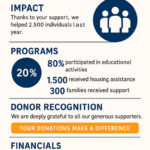Impact Reports Are a Stronger Donor Care Tool Than Annual Reports

In the nonprofit world, transparency and accountability are essential. For years, the annual report has served as the go-to tool for demonstrating how an organisation uses its funds and achieves its mission. But as donor expectations evolve—especially in the era of personalisation, storytelling, and digital engagement—another format has taken centre stage: the impact report.
While both reports have their place, impact reports are emerging as the more powerful donor care product, particularly when it comes to deepening relationships, expressing gratitude, and building trust.
Here’s why.
1. Impact Reports Speak to the Heart, Not Just the Head
Annual reports tend to be compliance-focused. They’re comprehensive, often filled with financial statements, board listings, and procedural updates. That’s important information for stakeholders and regulators—but not necessarily what inspires donors.
Impact reports focus on outcomes. They answer the question every donor asks themselves:
“Did my gift make a difference?”
By highlighting real stories, visual data, and outcomes achieved, impact reports stir emotion and reaffirm a donor’s decision to give.
🗨️ “Because of you, 3,200 families accessed safe shelter this year.”
That’s more powerful than a balance sheet.
2. They Are Donor-Centric, Not Organisational-Centric
Annual reports are often written for internal stakeholders, board members, or potential funders. They can be institutional in tone, with broad narratives about the charity’s year.
Impact reports flip the lens toward the donor. They emphasise the role of the supporter in making success possible, often using second-person language (“you made this happen”) and tailored stories of change.
This approach fosters a stronger emotional connection between the donor and the mission.
3. Shorter, More Engaging, and Easier to Share
Let’s be honest: most annual reports are long, text-heavy PDFs that sit unopened in inboxes or get skimmed at best.
Impact reports are built for engagement. They’re:
- Shorter (often 4–6 pages or a one-page digital snapshot)
- Designed with compelling visuals
- Optimised for sharing via email, social media, and events
This makes them far more likely to be read, remembered, and forwarded to others—expanding your message and your mission.
4. They Showcase Outcomes, Not Just Outputs
Annual reports often focus on outputs: how many meals served, events held, dollars raised.
Impact reports elevate the story by focusing on outcomes—the real-world change made possible through those efforts.
- Not just “10,000 books distributed,” but “literacy scores increased by 20%.”
- Not just “200 volunteers mobilised,” but “500 elderly people felt less isolated.”
This storytelling format makes donors feel like they’re not just giving to a program—they’re changing lives.
5. They Build Trust and Strengthen Donor Retention
When donors can see how their money made an impact, they’re more likely to give again.
Impact reports are a proactive donor care tool, closing the loop between giving and outcomes. They help reduce donor fatigue and skepticism by providing timely, transparent communication about how funds were used and what results were achieved.
In fact, research shows that donors who feel informed and appreciated are significantly more likely to continue giving.
6. Impact Reports are Versatile and Timely
Unlike annual reports, which are typically published once a year, impact reports can be produced multiple times throughout the year, allowing charities to:
- Share timely updates on specific campaigns
- Report on seasonal or emergency appeals
- Target specific donor segments (e.g., regular givers, major donors)
This makes them a nimble tool for engagement in a fast-moving fundraising environment.
Final Thought
Annual reports will always have a place in nonprofit accountability—but when it comes to donor stewardship, emotional connection, and showing the human side of your mission, the impact report is the stronger tool.
If you want your donors to feel thanked, valued, and inspired to keep giving, don’t just tell them what you did.
Show them the impact they made possible.
